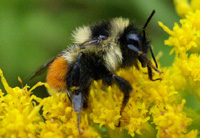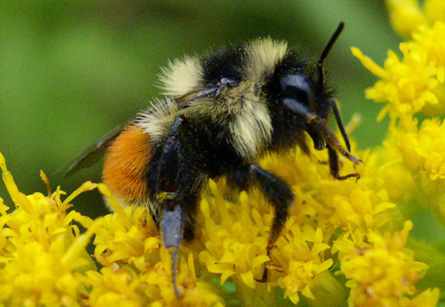 Wild pollinators are catching honeybee viruses, possibly from pollen.
Wild pollinators are catching honeybee viruses, possibly from pollen.
Eleven species of wild pollinators in the
Most of these native pollinators have n’t been recorded with honeybee viruses before, according to Diana Cox-Foster of
Wild pollinators are catching honeybee viruses, possibly from pollen
Eleven species of wild pollinators in the
Most of these native pollinators haven’t been recorded with honeybee viruses before, according to Diana Cox-Foster of
Gone are any hopes that viral diseases in honeybees will stay in honeybees, s
he says. “Movement of any managed pollinator may introduce viruses.”

Groping around for pollen in a flower could expose a wild bumblebee such as Bombus ternarius, shown here, to infection by honeybee viruses
A pattern showed up in the survey that fits that unpleasant scenario. Researchers tested for five viruses in pollinating insects and in their pollen hauls near apiaries in
ed up in wild pollinators near honeybee installations carrying the disease but not near apiaries without the virus.
In domestic honeybees, such viruses rank as one of the possible contributors to the still-mysterious malady known as colony collapse disorder that abruptly wipes out a hive’s workforce, Cox-Foster says.
Now she and others are looking at what the viruses do to wild pollinators. Preliminary results of ongoing lab tests show some disturbing effects, Cox-Foster says. “Is this part of the reason why we’ve seen the decline of native pollinator species in the
Surveys show that wild bumblebees, for example, are dwindling in numbers, and the new study raises further concerns. “We recognize that those viruses likely pose a major threat to wild bumblebees,” says Sarina Jepsen of the Xerces Society, an invertebrate conservation group in
One of the most interesting results in the study is the detection of deformed-wing virus and sacbrood virus in pollen carried by foraging bees that weren’t infected themselves, comments Michelle Flenniken of the
Healthy foraging insects carrying virus-laden pollen are one of the pieces of evidence that Cox-Foster and her colleagues use to argue that pollen by itself can transmit viral infections. “Knowing that viruses are found in and can be transmitted from pollen is an important finding,” says Flenniken.
This raises concerns about possible virus transmission through the 200 tons of honeybee-collected pollen used to feed bumblebees in bee-raising operations worldwide, Cox-Foster says.

 Previous page
Previous page Back to top
Back to top







